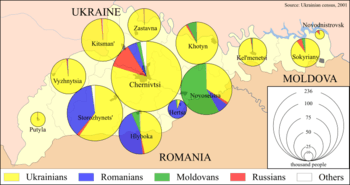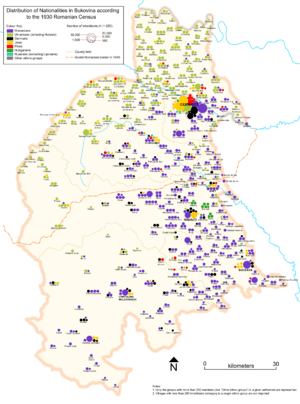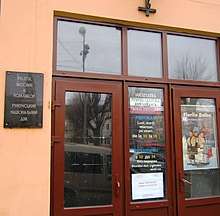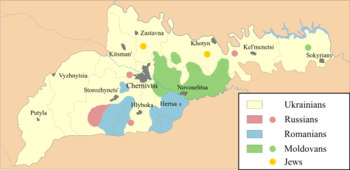Romanians of Chernivtsi Oblast
The ethnic Romanians of Chernivtsi Oblast (Romanian: Regiunea Cernăuți) in Ukraine comprise a significant portion of the Romanian diaspora in Ukraine.
 Ethnic division of the Chernivtsi Oblast according to the 2001 census results. Areas inhabited by Ukrainians, Romanians, Moldovans, Russians, and other ethnicities are depicted in yellow, blue, green, red, and white respectively. Circle sizes represent total population size in each area. Some consider Romanians and Moldovans to form a single ethnic group. | |
| Total population | |
|---|---|
| 114,555 (2001) | |
| Religion | |
| Romanian Orthodox Church | |
| Related ethnic groups | |
| Romanians in Ukraine, Romanians in Hungary |
History

Today's Chernivtsi Oblast of Ukraine was part of Romania between 1918 and June 1940, when it was occupied by the Soviet Union, and on 2 August 1940 it was transferred to the Ukrainian SSR. The region constituted the northern part of the historical region of Bukovina, the northern part of Hotin County of the region of Bessarabia, and the north-western corner of Dorohoi County (known as Hertza) of the region of Moldavia proper.
The Romanian population of Chernivtsi Oblast was persecuted by Soviet authorities on ethnic grounds, especially in the years following the annexation until 1956; because of this, Russification laws were imposed on Romanian population. In neighboring Bessarabia the same persecution did not have a predominantly ethnic orientation, being based mostly on social, educational, and political grounds.
Current situation

Since the Romanian Revolution of 1989, the official statements referring to this issue from the representatives of the Romanian community in Chernivtsi Oblast and from the Romanian government, have stated that there is no intent to revise the present internationally recognized border. However, the Romanian community has constantly addressed the following seven demands to the Ukrainian government:[1]
- to be officially recognized with the status of "native population" (as in Article 11 of the Constitution of Ukraine).
- to be officially recognized as a "population that was subject to deportations on ethnic grounds", as the Crimean Tatars, Germans, Armenians, Poles, and Jews are recognized, and to have official condemnation of the consequences of the Molotov-Ribbentrop Pact, such as the massive deportations of civilian populations, the massacres at Lunka and Fântâna-Albă, the alleged annihilation of entire villages of Frunză and Albovăţ
- to return to Romanian language the historic toponyms and geographic names, as allowed by the decision of the Congress of Deputies (Parliament) of the USSR on the 24 December 1989, believe to be still legally binding.
- to have ensured representation in the Ukrainian Parliament.
- to re-open the Romanian University in Chernivtsi.
- to re-open the Metropolitanate of Bukovina.
- to return from what was confiscated during the Soviet occupation, the property and the real estate of Romanian cultural organizations.
Geographic distribution

The bulk or 88% of ethnic Romanian population is concentrated in four of the eleven districts (raions) of the Chernivtsi Oblast situated closer to the border with Romania and Moldova. In the Hertsaivskyi Raion (Romanian: Herța), Romanians comprise about 95% of population. In Hlybotskyi Raion (Romanian: Adâncata), Romanians sum up to 45%. Storozhynetskyi Raion (Romanian: Storjineț) has a compact Romanian community in the south, especially around the village of Crasna. Romanians comprise 37% of that district's total population.
There are also other villages with a Romanian majority and important historical heritage, such as for example Boian (ancestral estate of Ion Neculce) and Cernăuca (home of the Hurmuzachi brothers). Other than the 4 raions have smaller Romanian populations, usually never exceeding several hundred people.[2][3]
Demographic evolution
| census | Ukrainians | Romanians | Moldovans | Russians | Jews | Germans, Poles, etc. | total |
|---|---|---|---|---|---|---|---|
| 1930 (last Romanian census) | 383,028 | 227,187 | - | 46,946 | 88,772 | 59,709 | 805,642 |
| 47.6% | 28.2% | - | 5.8% | 11.0% | 7.4% | ||
| 1959 (first Soviet census) | 518,189 | 79,790 | 71,645 | 51,268 | 42,140 | 11,089 | 774,121 |
| 66.94% | 10.31% | 9.26% | 6.62% | 5.44% | 1.43% | ||
| 1989 (last Soviet census) | 666,095 | 100,317 | 84,519 | 63,066 | 16,469 | 10,334 | 940,801 |
| 70.8% | 10.66% | 8.98% | 6.7% | 1.8% | 1.1% | ||
| 2001 (first Ukrainian census) | 689,056 | 114,555 | 67,225 | 37,881 | 1,443 | 8,868 | 919,028 |
| 75.0% | 12.4% | 7.3% | 4.1% | 0.2% | 0.965% | ||
| 1959 - 1989 difference | +147,906 | +20,527 | +12,874 | +11,798 | -25.671 | -755 | +166,680 |
| +28.54% | +25.72% | +17.96% | +23.01% | -60.92% | -6.8% | +21.53% | |
| 1989 - 2001 difference | +22,961 | +14,238 | -17,294 | -25,185 | -15,026 | -1,466 | -21,773 |
| +3.45% | +14.19% | -20.46% | -39.9% | -91.24% | -14.2% | -2.3% | |
- Note: The data in this table is based on the official census data in Romania (1930), the Soviet Union (1959-1989), and Ukraine (2002), and reflect the composition of the population according to the present boundaries, including were administrative divisions before 1940 were different. In such cases, the figures in the table were obtained by adding them settlement by settlement according to today's configuration of the region.[4] While in the 1930 census no one was officially registered as Moldovan, The 1959, 1989 and 2001 censuses did allow separate registration of the Moldovans.
See also
- History of the Romanians in Ukraine
- Soviet occupation of Bessarabia and Northern Bukovina
- Fântâna Albă massacre
Notes and references
- (in Romanian) Gabriel Gherasim, Românii din Ucraina (2) Archived 2007-11-13 at the Wayback Machine ("Romanians in Ukraine (2)"), Noi, NU!, August 7, 2005. Accessed online October 31, 2006.
- (in Romanian) Gabriel Gherasim, Românii din Ucraina (1) Archived 2008-03-22 at the Wayback Machine ("Romanians in Ukraine (1)") Noi, NU!, August 2005. (Page 4.) Accessed online October 31, 2006.
- 2001 Ukrainian Census | English version | Results | General results of the census | National composition of population | Chernivtsi region Archived 2007-11-13 at the Wayback Machine
- (in Romanian) Gabriel Gherasim, Românii din Ucraina (2) ("Romanians in Ukraine (2)"), Noi, NU!, August 7, 2005. (Page 2.) Accessed online October 31, 2006.
External links
- (in Romanian) Gabriel Gherasim, "Românii bucovineni sub cizma străină", Ziua, August 16, 2005
